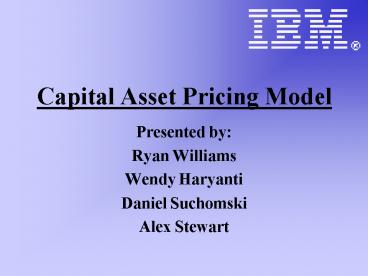Capital Asset Pricing Model - PowerPoint PPT Presentation
1 / 32
Title:
Capital Asset Pricing Model
Description:
Capital Asset Pricing Model. Presented by: Ryan Williams. Wendy Haryanti. Daniel Suchomski. Alex Stewart. PURPOSE ... 1. The S&P 500 contains 75% of all the ... – PowerPoint PPT presentation
Number of Views:1706
Avg rating:3.0/5.0
Title: Capital Asset Pricing Model
1
Capital Asset Pricing Model
- Presented by
- Ryan Williams
- Wendy Haryanti
- Daniel Suchomski
- Alex Stewart
2
PURPOSE
- To develop a likely range of IBMs Cost of Equity
using the CAPM Model
3
IBM
- Develops, manufactures, and markets advanced
information processing products. - Including
- computers
- software
- networking systems
- other information technical related services
4
CAPM MODEL
- Ke Krf (Km-Krf)B
- Ke Return on Equity
- Krf Risk Free Rate
- Km Expected Market Return
- B Beta
5
Assumptions about Km
- Historically, IBM has used the
- S P 500 as the market portfolio.
- WHY?
6
Why S P 500?
1. The SP 500 contains 75 of all the value of
the stock market. 2. It contains the longest
history of Market returns, making it the industry
norm.
7
T-Bills or T-Bonds ?
- For long term forecasts of Ke, IBM will be using
20 yr T-Bonds. - WHY?
8
Why T-Bonds?
- For long term estimates, we want to use a rate
that has long term inflation built into it.
9
Beta A measure of how sensitive an individual
stocks return is relative to changes in Markets
return. Mkt Beta 1.0 Go to Excel
10
Time Series of IBM Beta
11
Confidence Intervals for IBMs Beta
- Based on Regression, Beta .804
- 95 confidence .003 - 1.6
- 68 confidence .40 - 1.21
12
Because Betas tend to Regress towards 1.0, and
the uncertainty that surronds a Beta estimate, we
will use an adjusted beta in our Cost of Equity
Evaluation.
13
Adjusted Beta
- Adj Beta 2/3(.804) 1/3(1.0)
- Adj Beta .869
14
Market Risk Premium
- The premium that investors require
for bearing the risk of an Average stock
15
Assumptions for RPm
- The SP will be used as the Mkt return.
- The Risk free rate will be represented by yield
to maturity on - Long Term bonds.
16
Two Approaches to Estimating Market Risk Premium
- 1. Prospective
- 2. Historical
17
Prospective
- Estimate the expected return on stock market and
then subtract the current risk free rate. - Problem Requires estimates of future dividend
growth
18
Historical
- Calculate the average risk premium which
investors have actually earned in the past.
19
Logic of Historical
- On average, investors will receive what they
expect. So lets look at what they have received
to estimate the risk premium they have desired in
the past. - Go to Excel
20
Geometric Estimate of RPm
- RPm Geometric SP - Geometric LT T-Bond
- 5.61 10.71 - 5.10
- RPm 5.61
21
Risk Free Rate Krf
- We will be using todays Yield to Maturity on 20
year T-Bonds - Krf 6.5
22
Range of CAPM
- Range of Beta (68) .4 -1.21
- 1. Beta .4, krf 6.5, RPm 5.61
- CAPM 6.5 (5.61).4 8.74
- 2. Beta 1.21, Krf 6.5, Rpm 5.61
- CAPM 6.5 (5.61)1.21 13.29
- CAPM Range, (8.74-13.29)
23
Final CAPM Calculation
- CAPM Krf (RPm)B
- 6.5 (5.61).869
- CAPM 11.37
24
Limitations of CAPM
- Assumptions of CAPM
- Beta Stability
- Fama - French Study
- The CAPM today
25
Assumptions of CAPM
- 1. All investors can borrow and lend an
unlimited amount at a given risk free rate of
interest. - 2. No transaction costs
- 3. No Taxes
26
Beta Stability
- Past Betas for individual stocks are historically
unstable. - Therefore not good proxies for future estimates
of Beta.
27
(No Transcript)
28
Is Beta Useful?
- Yes, It is useful when measuring the risk
associated with a portfolio of stocks.
29
Betas in Portfolios
- Number of Stocks
- 1 2 4 7 10 20
50 - R2 between Beta Estimates
- .36 .53 .71 .77 .86 .95 .96
30
Fama -French Study
- Found no relationship between Beta and
Return - Concluded that firm size and market book ratios
give a better much better estimate of return
31
Conclusions of CAPM
- Although CAPM has its limitations , it is a
widely accepted tool in todays business world.
32
THANK YOU
(INSERT APPLAUSE HERE)































